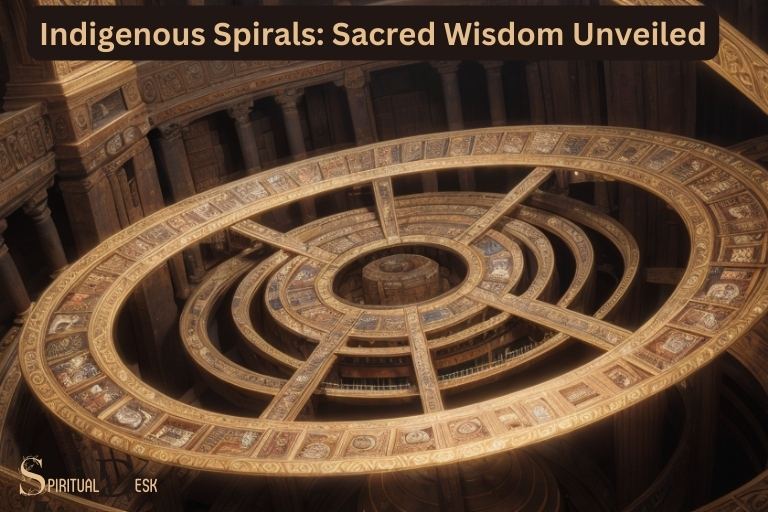Indigenous Spirals: Sacred Wisdom Unveiled
Indigenous spirals or sacred spirals are symbolic representations mainly found in indigenous cultures around the world. They typically represent concepts of growth, evolution, life-death-rebirth, spiritual journey, and harmony with nature.
Quick Overview
The indigenous spiral symbol takes on profound meanings across different cultures. Its simple yet powerful form encapsulates key aspects of these societies’ fundamental beliefs and values.
For instance, Native Americans use it to depict eternal life and their deep connection to Mother Earth. Similarly, Australian Aboriginals see it as a representation of ancestral beings from Dreamtime stories retold through generations.
These diverse interpretations show how this ancient symbol continues to resonate with people’s innate yearning for understanding life’s mysteries and our place within them.

Spirals In Indigenous Art And Craftsmanship
Spirals have long been recognized as powerful symbols in indigenous spiritual practices. They are not only significant in the realm of spirituality but also hold a prominent place in indigenous art forms and craftsmanship.
In this section, we will explore how spirals are portrayed in indigenous art and delve into the symbolic representation and cultural significance of this intriguing motif.
Spirals As Prominent Motifs In Indigenous Art Forms
Indigenous art is renowned for its vibrant and intricate designs, and spirals are often featured as prominent motifs. These beautiful and captivating swirls can be found in various art forms, including pottery, weaving, and jewelry.
The utilization of spirals in these artistic expressions showcases the rich creativity and spiritual symbolism that permeates indigenous cultures.
Symbolic Representation Of Spirals In Pottery, Weaving, And Jewelry
In indigenous art forms like pottery, weaving, and jewelry-making, spirals hold symbolic significance:
- Pottery: Spirals in pottery symbolize eternal life, growth, and cyclical natural patterns. They are intricately carved or painted to convey the spiritual connection with nature.
- Weaving: Weaving patterns incorporate spirals to represent the interconnectedness of all beings, reflecting harmony between humans, animals, and the environment.
- Jewelry: Indigenous jewelry features spiral designs in necklaces, bracelets, and earrings, signifying life’s continuous journey, seasonal cycles, and the perpetual flow of energy. It encourages staying connected to nature and embracing life’s ever-changing nature.
Cultural Significance Of Spirals In Indigenous Artistic Expression
Spirals hold deep cultural significance in indigenous artistic expression, representing spirituality, continuity, and reverence for nature.
Spirals in indigenous art serve both as aesthetics and as a way to preserve cultural heritage and pass down ancestral knowledge through generations.
Indigenous artists use spirals to honor their roots and maintain the wisdom and traditions of their ancestors.
Spirals As Pathways To Spiritual Enlightenment
Indigenous spiritual practices weave a tapestry of ancient wisdom and profound knowledge, offering rich insights into the depths of human existence. One symbol that holds significant meaning in these traditions is the spiral. Spirals are not merely decorative motifs; they serve as powerful metaphors for spiritual growth, self-discovery, and the journey towards enlightenment.
Spirals As Symbolic Representations Of Spiritual Growth And Self-discovery
- Cyclical Nature: Spirals represent life’s cyclical and interconnected nature, mirroring the journey of growth and self-discovery.
- Outward Expansion: Like the spiral’s outward expansion, we broaden our understanding and connection to the divine, elevating our consciousness.
- Inward Journey: Spirals also symbolize the inner journey, as we explore our deepest fears and limitations. This process transforms them into sources of strength and wisdom, aligning us with our higher purpose.
Practices For Utilizing Spirals To Deepen Spiritual Connection
Integrating spirals into our spiritual practices can enhance our connection with the sacred and deepen our understanding of the divine. Here are some practices to consider:
- Meditation: Begin your meditation practice by envisioning yourself within a spiral. As you breathe in and out, visualize yourself moving along the twists and turns of the spiral, exploring the depths of your being and expanding your consciousness.
- Sacred Art: Create or observe artwork featuring spirals, allowing their intricate patterns to evoke a sense of wonder and connection. Engaging with their symbolism through aesthetics can awaken spiritual insights and foster a deeper understanding of oneself.
- Rituals and Ceremonies: Incorporate spirals into rituals and ceremonies as a representation of the spiritual journey. Create sacred spaces adorned with spirals, invite participants to trace spirals with their fingers or bodies, and use spiral-shaped objects as ritual tools. These practices can infuse the experience with powerful symbolism and intention.
Remember, the key is not only to observe the spiral but to engage with it intentionally, allowing it to guide your explorations and facilitate transformative experiences.
Spirals As Tools For Aligning With Higher Consciousness
Aligning with higher consciousness is a goal shared across various spiritual traditions. The spiral serves as a potent tool in this pursuit, promoting alignment and attunement to the divine. By understanding spirals as energy pathways, we can consciously direct our intentions and create a harmonious flow of cosmic energy.
As we follow its curves, we step into a space where higher consciousness becomes accessible. The spiral provides us with a roadmap for spiritual alignment, gently guiding us toward expanded awareness, profound insights, and a profound connection with the divine.
By embracing spirals in our spiritual journey, we embark on a transformative path of self-discovery, deepen our connection with the sacred, and align ourselves with higher consciousness.
Ancient Origins Of Spirals In Indigenous Cultures
Throughout the rich tapestry of indigenous cultures around the world, spirals have long been a prominent symbol with deep spiritual significance.
These ancient origins of spirals reflect a profound connection between indigenous communities and the natural world. From rock art to creation stories, cultural diversity to variations in symbolism, the presence of spirals in indigenous cultures is both captivating and enlightening.
Prevalence Of Spirals In Rock Art And Ancient Artifacts
These spirals, carefully etched or painted onto stone surfaces, hold a significant place in the spiritual practices of many indigenous communities, acting as a visual representation of their beliefs and connections to the divine.
Indigenous rock art across different regions showcases a diverse range of spiral motifs, emphasizing the universality of this symbol.
From the petroglyphs of Australia’s Aboriginal communities, featuring concentric spirals, to the ancient cave paintings in North America portraying double spirals, it is evident that spirals played a central role in conveying indigenous spirituality and cultural identity.
Spirals In Indigenous Creation Stories And Cosmology
Spirals have not only left their mark in rock art but also feature prominently in indigenous creation stories and cosmology.
These captivating narratives often depict spirals as fundamental components of the world’s creation, representing the cyclical nature of existence and the interconnectedness of all living beings.
Cultural Diversity And Variations In Spiral Symbolism
In Maori culture, the koru spiral signifies new beginnings, growth, and harmony with nature, resembling the unfurling of a fern frond and symbolizing life’s journey and personal growth.
In Celtic traditions, the triskele spiral represents the connection between body, mind, and spirit, embodying the eternal cycle of life, death, and rebirth.
Honoring Spirals In Indigenous Spiritual Practices Today
These ancient civilizations recognized the inherent wisdom and beauty of spirals, integrating them into their spiritual practices as a way to honor their cultural traditions and establish a harmonious relationship with the natural world.
Today, it is crucial that we preserve and respect indigenous cultural traditions, including the sacred use of spirals, as they offer valuable insights into sustainable living, holistic well-being, and spiritual growth.
Importance Of Preserving And Respecting Indigenous Cultural Traditions
Indigenous cultural traditions are invaluable repositories of wisdom, passed down through generations, offering profound insights into sustainable living, community cohesion, and spiritual fulfillment.
It is our collective responsibility to preserve and respect these traditions, ensuring their safeguarding for future generations.
Embracing And Learning From The Wisdom Of Spirals In Modern Spirituality
The wisdom encapsulated within spirals extends beyond indigenous cultures and has relevancy in modern spirituality as well.
By embracing the wisdom of spirals in our own spiritual practices, we cultivate a deeper understanding of ourselves and our connection with the world around us.
The spiral serves as a reminder to be open to change, to embrace our own unique journey, and to approach life with curiosity and willingness to learn.
Call To Action: Supporting Indigenous Communities And Their Spiritual Practices
If we truly value the wisdom present within indigenous spiritual practices, we must actively support indigenous communities in their efforts to maintain and revitalize their traditions.
This includes providing resources, funding, and platforms for indigenous voices to be heard, as well as engaging in cultural exchanges and educational initiatives.
By participating in these efforts, we demonstrate our commitment to cultural diversity and the preservation of indigenous knowledge systems.
Exploring Sacred Spirals In Indigenous Rituals And Ceremonies
This article explores sacred spirals in indigenous rituals and ceremonies, highlighting their significance as powerful symbols deeply rooted in nature and interconnectedness.
Incorporation Of Spirals In Healing Rituals And Ceremonies
Spirals play a significant role in indigenous healing rituals and ceremonies. They symbolize growth, renewal, and transformation, connecting individuals with the cycles of life and their innate healing energies.
Spiral dances performed during these ceremonies create a powerful energy vortex, aiding in the release of blockages and restoring balance. The spiral also represents personal transformation and healing on physical, emotional, mental, and spiritual levels.
Use Of Spirals As Symbols Of Protection And Warding Off Negative Energy
Spirals have long been recognized as potent symbols of protection in indigenous spiritual practices. These sacred symbols are believed to create an energetic barrier that shields individuals and spaces from negative influences and malevolent forces.
The continuous and interconnected nature of the spiral is thought to represent an unbroken flow of energy that acts as a protective shield against any harmful energies that may attempt to enter.
Role Of Spirals In Vision Quests And Spiritual Journeys
Spirals play a key role in indigenous vision quests and spiritual journeys, symbolizing cosmic energy and guiding individuals.
In natural surroundings, participants find inspiration in spiraling patterns, embarking on transformative spiritual journeys leading to personal insights and communion with the divine.
Spirals In Indigenous Environmental Stewardship And Conservation
Spirals in Indigenous Environmental Stewardship and Conservation
Indigenous Teachings On The Interconnectedness Of Nature And Spirituality
Indigenous cultures have long recognized the deep connection between the natural world and spirituality.
In their teachings, the spiral symbolizes this interconnectedness, representing the continuous flow of energy and life force that exists within and between all living beings.
The spiral teaches us that everything is intricately linked in a web of relationships, and that our actions in the natural world have reverberating effects.
These teachings emphasize the importance of seeing nature as a sacred, living entity that deserves respect and protection.
By recognizing our place within the larger ecological system, Indigenous peoples have developed a rich body of traditional ecological knowledge that guides their sustainable practices and environmental stewardship.
Utilization Of Spirals In Traditional Ecological Knowledge And Sustainable Practices
Indigenous peoples have long utilized spirals in their traditional ecological knowledge and sustainable practices. The spiral is seen as a powerful symbol that represents the cyclical processes of nature, such as the seasons, the cycles of life and death, and the constant renewal of the natural world.
One example of the utilization of spirals in Indigenous sustainable practices is the understanding and observation of natural patterns. The spiral shape can be found in many aspects of the environment, from the spiraling patterns of water currents and whirlpools to the growth patterns of certain plants and trees. By studying and understanding these patterns, Indigenous communities are able to make informed decisions about resource management, harvesting, and conservation.
Spirals As Symbols Of Harmony, Balance, And Respect For The Natural World
Indigenous spirituality views spirals as symbols of harmony, balance, and respect for nature, representing interconnectedness and cooperation.
This symbolism fosters respect and gratitude for nature’s gifts. Indigenous communities prioritize responsible stewardship to preserve ecosystems for future generations.
Conclusion
Spirals in indigenous spirituality symbolize the connection between spirituality and nature, representing cyclical forces.
Indigenous practices emphasize interconnectedness and living harmoniously with nature. We should appreciate indigenous wisdom, learn from their practices, and protect our environment.






